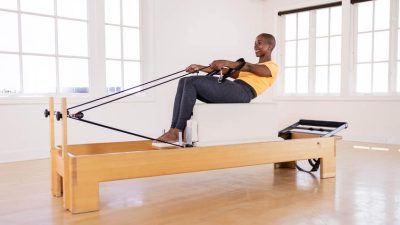
By Polestar UK Mentor Kristin Loeer. If you are interested in learning more about Kristin’s approach to working with the breath in Pilates you may be interested in the upcoming workshop “The Movement of Breathing” which will be hosted by Polestar Pilates UK in November 2022.
I have never met a client who was not confused or insecure about the nature and function of their breathing. In fact, I have never met a client who, when asked about it, did not assume that they are “probably breathing badly”. People are exposed to plenty of breathing cues in Pilates and Yoga classes. Outside of the studio, there is also an abundance of breathing practices and breathing apps.
So why is there such confusion and lack of confidence about breathing? And secondly, I dare ask, do we, as movement professionals who cue breathing all the time, feel all that confident about it ourselves?”
After all, we may have learned that thoracic breathing is the way to go. Or we were told that deep diaphragmatic breathing is important. We may feel compelled to remind people to take deep breaths during movement because we see their tendency to hold their breath. Then again we may wonder about the exhale because if we do not breathe out we can not take in fresh air either. When we add Pilates to the equation and start talking about inhaling and exhaling in relation to movement we can easily overwhelm our clients, if not ourselves.
The Breath as Autonomic and Conscious Process
The reason why the subject of breathing causes never-ending confusion is that breathing is both a very finely tuned autonomic process, as well as under our conscious control. Hence it can be altered, but we may wonder whether it should be. This will always have a very complex impact on the rest of our being.
Just like digestion or heart rate, breathing is orchestrated largely by our autonomic nervous system. The autonomic nervous system is influenced by our life experiences. It is constantly responding and adapting to external and internal changes. Its main concern at all times is homeostasis and survival.
The Breath As A Tool
As mentioned, unlike heart rate and digestion, breathing is also under our conscious control. I can choose to lengthen my exhale or to hold my breath. I do not have the same control over my heartbeat or digestive processes. This makes breathing such a powerful tool. We can use it when we want to become calmer or more alert and of course, it gives us the opportunity to optimize movement through breath.
I am a practitioner, who specializes in somatic trauma work. My belief is that it is important to remember that while we can alter our breathing and create powerful change through it, breathing is a carefully and deliberately orchestrated nervous system process. No matter how inefficient or dysregulated a client’s breathing pattern may seem, in my experience, it is never random. There is no such thing as “lazy breathing”, “wrong breathing” or “I forget to breathe”.
There is nothing the nervous system does without good reason or without its key concern being survival.
This does not mean that we should not work with our breath. It means that we need to go about it gently and respectfully. We need to be aware that there is a reason for the client’s current breathing pattern, and that if we try to alter it, there may be pushback from the client’s nervous system. We can bring about positive change indeed if the nervous system recognizes that this change in breathing is helpful. On the other hand, if we are not careful we might promote a messy interference with the nervous system’s autonomic process, which does not serve the client well.
Here are my six top tips for how to work with the breath in both private Pilates sessions and group classes:
1. Observe The Breathing Pattern
Particularly in private sessions, we have the opportunity to observe our client’s breathing both in stillness and motion.
Let’s not be too hasty with our wish to help them use their breath better. Let’s be curious about what their body is naturally doing. Also, consider how breath might change automatically as we work with using other cues. It is very possible that your soothing voice or their awareness of their body’s movement against the ground settles their nervous system. This alone might regulate their breathing without you having to address it directly.
2. Make Breathing Cues Relevant To The Client.
As with movement, respond to what you are observing rather than using generic, popular cues.
Some people do indeed breathe shallowly. Others have already been told they do so and are now stuck in compensating patterns of excessive abdominal breathing. Many people inhale more than they exhale, however, there are also a fair few people who stretch their exhales and barely feel the need to inhale. The point is that no one person breathes the same and we need to be careful not to generalise and give people cues that are not useful to them.
3. In Group Classes: Offer Different Breathing Cues To Explore.
In group classes, it is much harder to observe and attend to individuals of course.
We need to be aware that not one breathing cue will work or be right for everyone. Let’s provide different options so that they can explore and be inspired by the cues that feel good to them. You might ask them to become aware of how much they breathe in compared to how much they breathe out. You might suggest they try out opposite options within an exercise to let them decide what feels right for them. Also, give people the option to ignore the breath-related cues altogether. They may simply not be in a place where they feel safe to explore their breathing patterns.
4. Use Positive And Invitational Language
Whether you work with individuals or a group, when it comes to breathing I strongly recommend using invitational language.
Let’s remember that the nature of our breathing is closely linked with our sense of survival. It is important to put the client in charge of their breath. Encourage them to be present and curious with their breath. Reassure them that while they may want to try out making changes, their natural breathing is not wrong and they can return to it whenever they want.
5. There Is No Failure.
A client may simply not be able to access the shift in breathing we are encouraging them to find.
This may bring about a sense of failure in the client. Let’s remember that the nervous system always has the final say and if it does not deem a change safe it will not allow it. You can communicate this to the client by explaining how their body is “saying no” to this today and how over time it can change its mind”. Encourage the client to explore and “play with this again later.”
6. Bring Awareness To The Impact
If the client’s breathing does change, allow them time to experience this without adding any further new information or cues.
It can take a few minutes to explore this and to become aware of the holistic impact this change has had. They may feel calmer, stronger, or experience more flow in the movement. This positive shift is really worth exploring! It has the potential to integrate and perhaps become the new normal. They may become emotional, anxious, or irritated and feel their movements ‘disintegrate’. It is important for the client to experience whether this shift is positive for them or not. They can revert back to their previous way of breathing if they need to.
If you would like to learn more about my approach to working with the breath in Pilates you may be interested in my upcoming workshop “The Movement of Breathing” which I will be running for Polestar Pilates UK in November 2022. For more information please contact me @kristinloeer_movement .







